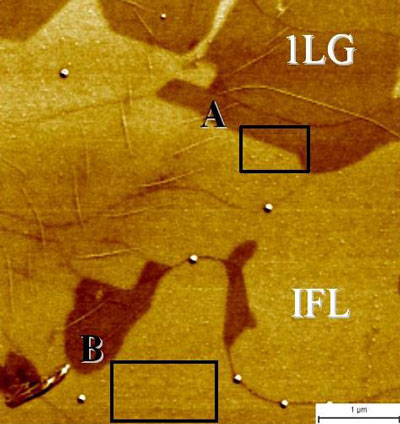| Sep 28, 2012 |
Graphene: the thickness of it
|
|
(Nanowerk News) One of the best ways of producing high quality graphene is to grow it epitaxially (in layers) from crystals of silicon carbide. For use in electronic devices, it is important to be able to count the number of graphene layers that are grown, as single and double layers of graphene have different electrical properties.
|
|
There is a general belief that this should be a simple enough process, as one layer of graphene is assumed to be 335 picometres high. But, research has shown that for graphene grown on silicon carbide, the layer thickness can vary anywhere between 85 and 415 picometres, depending on how the layers are stacked. Unfortunately, some experiments are still relying on simple height measurements to identify graphene thickness, which can produce ambiguous results.
|
 |
| An EFM phase image showing one layer graphene (1LG) and the interface layer (IFL)
|
|
Recent National Physical Laboratory research, published in the Journal of Applied Physics ("Identification of epitaxial graphene domains and adsorbed species in ambient conditions using quantified topography measurements"), looked at different topography approaches of determining graphene thickness and investigated the factors that can influence the accuracy of the results, such as atmospheric water and other adsorbates on the graphene surface.
|
|
This research demonstrated that electrostatic force microscopy (EFM) imaging is the most straightforward way to identify graphene layers of different thicknesses. It also showed that simple height measurements can agree very well with models, once an absorbed substance on single layer graphene, thought to be water, is taken into account and factored into the measurements.
|
|
The techniques used in this work, and the knowledge gained from it, will help improve our ability to characterise graphene layers and may lead to reference samples and calibration methods, which will be vital to support the emergence of graphene-based electronic devices.
|

